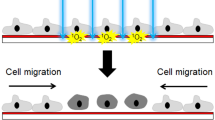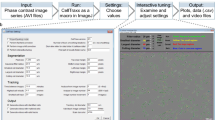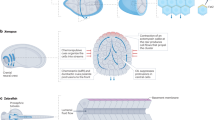Abstract
The in vitro scratch assay is an easy, low-cost and well-developed method to measure cell migration in vitro. The basic steps involve creating a “scratch” in a cell monolayer, capturing the images at the beginning and at regular intervals during cell migration to close the scratch, and comparing the images to quantify the migration rate of the cells. Compared to other methods, the in vitro scratch assay is particularly suitable for studies on the effects of cell–matrix and cell–cell interactions on cell migration, mimic cell migration during wound healing in vivo and are compatible with imaging of live cells during migration to monitor intracellular events if desired. Besides monitoring migration of homogenous cell populations, this method has also been adopted to measure migration of individual cells in the leading edge of the scratch. Not taking into account the time for transfection of cells, in vitro scratch assay per se usually takes from several hours to overnight.
This is a preview of subscription content, access via your institution
Access options
Subscribe to this journal
Receive 12 print issues and online access
$259.00 per year
only $21.58 per issue
Buy this article
- Purchase on SpringerLink
- Instant access to full article PDF
Prices may be subject to local taxes which are calculated during checkout


Similar content being viewed by others
References
Todaro, G.j. et al. The initiation of cell division in a contact-inhibited mammalian cell line. J. Cell Physiol. 66, 325–333 (1965).
Haudenschild, C.C. et al. Endothelial regeneration. II. Restitution of endothelial continuity. Lab. Invest. 41, 407–418 (1979).
Etienne-Manneville, S. et al. Integrin-mediated activation of Cdc42 controls cell polarity in migrating astrocytes through PKCzeta. Cell 106, 489–498 (2001).
Fukata, Y. et al. Phosphorylation of adducin by Rho-kinase plays a crucial role in cell motility. J. Cell Biol. 145, 347–361 (1999).
Abbi, S. et al. Regulation of focal adhesion kinase by a novel protein inhibitor FIP200. Mol. Biol. Cell. 13, 3178–3191 (2002).
Acknowledgements
This work was supported by NIH grants GM48050 and HL73394 to J.-L. Guan.
Author information
Authors and Affiliations
Corresponding author
Ethics declarations
Competing interests
The authors declare no competing financial interests.
Rights and permissions
About this article
Cite this article
Liang, CC., Park, A. & Guan, JL. In vitro scratch assay: a convenient and inexpensive method for analysis of cell migration in vitro. Nat Protoc 2, 329–333 (2007). https://doi.org/10.1038/nprot.2007.30
Published:
Issue date:
DOI: https://doi.org/10.1038/nprot.2007.30
This article is cited by
-
A new physiological medium uncovers biochemical and cellular alterations in Lesch-Nyhan disease fibroblasts
Molecular Medicine (2024)
-
An automated in vitro wound healing microscopy image analysis approach utilizing U-net-based deep learning methodology
BMC Medical Imaging (2024)
-
A Review of Fabrication and Applications of Confined Microchannels for Cell Migration Assay
International Journal of Precision Engineering and Manufacturing (2024)
-
Biopolymer-based Sustainable Membrane for Skin Regeneration
Materials Circular Economy (2024)
-
Synergistic effects of dendrosomal nanocurcumin and oxaliplatin on oncogenic properties of ovarian cancer cell lines by down-expression of MMPs
Biological Research (2023)



